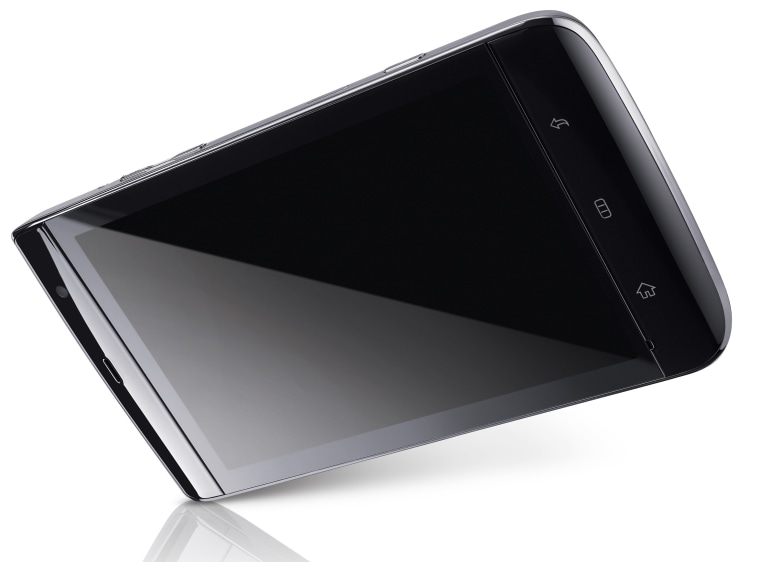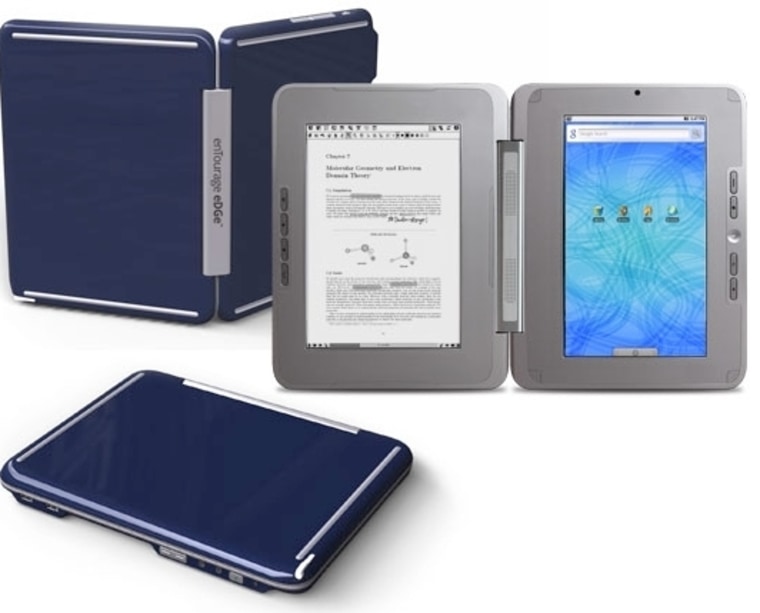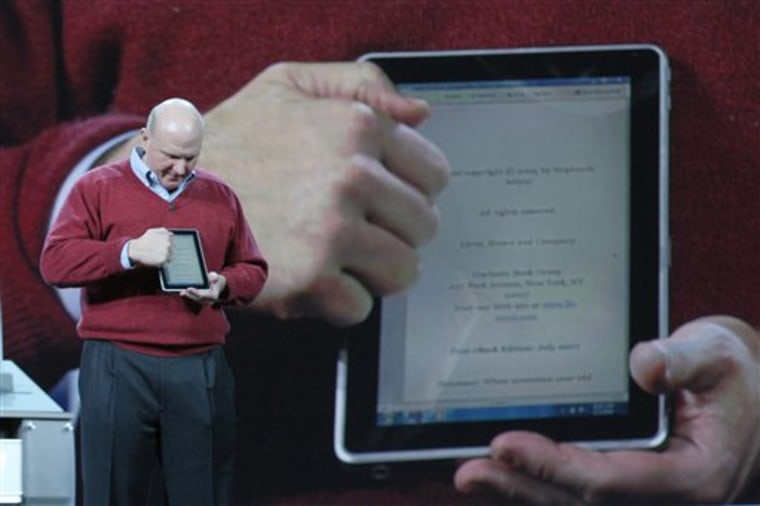The tech doctor's advice this year: "Take two tablets and call me in the morning. Better yet —take three tablets. Just take a tablet — please!" There are going to be dozens of them from which to choose, and those on display at the Consumer Electronics Show in Las Vegas represent just the start of the slate onslaught.
One not on display but on everyone's minds is a tablet that Apple may introduce later this month (wrote one pundit: "The most eagerly awaited tablet since Moses delivered the Ten Commandments may be only weeks away from launch.")
Shawn DuBravac, director of research for the Consumer Electronics Association, sponsor of CES, classifies the new tablets as "Tablet 2.0."
"Tablet 1.0 was very IT-centric, and it was really an extension of a notebook computer," he said. "Tablet 2.0 is likely to be more entertainment-centric. It feels a lot like Tablet 2.0 is going to emerge out of two great success stories: the e-reader and the netbook computer."
If you're wondering what the differences are among e-readers, netbooks and tablets, you're not alone. The definitions can be different depending on which company or analyst you ask, and some devices are a combination of the above. There are tablet notebooks and smartbooks and even "hybrids" (as Lenovo is calling one of its new laptops with a detachable tablet screen).
"The all-elusive tablet," is how Jim McGregor, In-Stat chief technology strategist, described it in a recent report. It's "a category that has many definitions and can include everything from a hybrid notebook PC with a flip-around touchscreen to the MIDs (Mobile Internet Devices) that Intel and partners have pushed over the past few years."
Generally, e-readers are stand-alone devices, like Amazon's Kindle, which happens to be in tablet form (most e-readers are). Tablets are viewed as Web- and entertainment-oriented — movies and TV — but can also be used to read, and generally have a touchscreen keyboard.
Netbooks also can be used for watching video or reading, as well as doing more traditional computer tasks. Many of the new ones being shown at CES have smaller screens and form factors than the current crop of netbooks that have 9- and 10-inch displays.
No matter what, all of them are portable, on-the-go devices with Internet access, much like smartphones.
Whether tablets will fare as well as e-readers and netbooks remains to be seen. E-readers are just starting to take off — mainly because of the Kindle — and netbooks have had appeal because of their size and their relatively low prices, between $300 and $400.
Cost factor
The economy may be starting to show a glimmer of recovery, but are consumers ready to open their wallets a little wider for tablets, with prices for many starting at $500 and up?
Perhaps they will with a subsidy from wireless phone carriers. Many carriers now reduce the prices of phones and netbooks if customers agree to a two-year service contract. Monthly data costs are around $60, and over 24 months, the real cost of a netbook ends up being much higher than if it were purchased without wireless service.
"This remains a market focused on saving money and it will have a great deal of difficulty accepting yet another device that requires a $60-plus monthly fee associated with it regardless of what the device (itself) costs," said technology analyst Rob Enderle.
One company, Freescale Semiconductor, has developed a 7-inch touchscreen device "intended to enable a second generation of smartbook products with prices less than $200," and "provide instant-on functionality, persistent connectivity and all-day battery life."
The company is seeking a manufacturer for the device, which would use either the Android or Linux operating systems, the latter still not widely used by consumers.
"The Freescale tablet appears to be another solution in search of a problem," noted Michael Gartenberg, vice president of strategy and analysis at Interpret, LLC on Twitter recently. "The device's Linux-based ecosystem isn't going to help."
Tablet fever
An Apple tablet — if one is coming — likely would set the standard for others, much in the way its iPhone did for mobiles. But many companies are not waiting to see what Apple does or doesn't do.
HTC and Google are reportedly jointly working on a tablet. HP and Dell have announced they'll have their own tablets. Reportedly, Microsoft will too, although during CEO Steve Ballmer's CES speech he shared an HP slate prototype, not Microsoft's talked-about "Courier" tablet(Msnbc.com is a joint venture of NBC Universal and Microsoft.)
Just as with netbooks and e-readers, it seems everyone is going to be making a tablet or a combination thereof. Among the devices recently announced:
- The enTourage eDGe has two screens and is billed as an e-reader and tablet, as well as netbook, notepad, and "audio/video recorder and player in one." The eDGe uses Google's Android operating system, and is scheduled to ship Feb. 10. Cost: $490.
- The Litl Webbook has a 12-inch screen, and its keyboard flips around so the device can stand upright for viewing photos, reading news headlines or watching online videos, according to the developer. Cost: $699, and it is available now.
- Notion Ink is coming out with an Android-based tablet and scheduled for release in June. Estimated cost: $325.
- The JooJoo, formerly known as the CrunchPad, has a 12.1-inch touchscreen. Cost: $499. Due to start shipping soon.
- Lenovo unveiled its IdeaPad U1 hybrid notebook at CES. The U1, available June 1 for $999, has a detachable 11.6-inch high-definition LED screen that includes its own processor, and is an "independent slate tablet." It can be used for e-mail, social networking, Web surfing, music and photos.

Piper Jaffray analyst and Apple expert Gene Munster said recently that an Apple tablet would likely launch in March.
Two screen sizes, 7 and 10 inches, have been mentioned, and pricing of between $600 and $1,000 has been the buzz on the Web. But no one knows for sure right now, and Apple never comments on products that are in development.
"The reason everyone is excited about Apple potentially entering the space is because it tends to expand the capabilities of what people (think) a device could be used for," said Ross Rubin, director of industry analysis for The NPD Group research firm.
"However, as Apple TV (an add-on device) has shown, sometimes there are market-size limitations even Apple’s forethought and design acumen can’t circumvent."
Appealing screen size
DuBravac of CEA says that e-readers and netbooks — "very nascent categories until 2009" —both "occupy a screen size category that isn’t utilized by very many products," the 5- to 15-inch size range.
Many tablets, he said, "fit squarely between that 5- to 15-inch category. A lot of tablets they’re talking about are coming right in at that 10-inch size."

That should hold appeal for users on the go, or looking to snuggle up at home with a good tablet, witness the popularity of the slate-style Kindle e-reader with its 6-inch screen. Netbooks, too, have found a place in the home as much as on the road, CEA's research shows.
"People are using these devices primarily in their home, in the living room and in the bedroom, and they’re multitasking," said DuBravac.
"They’re simultaneously consuming two streams of information — watching TV while Facebooking with their friends, or watching TV while tweeting," sometimes about the shows they're watching.
And while smartphones, such as the iPhone, BlackBerrys or Palm Pre, might seem good candidates for digital movies or TV, battery life — and display size — are issues.
"It's much more enjoyable to watch a movie or TV show on a 10-inch screen than on a 2- or 4-inch screen," DuBravac said. "And if it’s a device you’re not taking with you in every instance, then 10 inches is a very comfortable screen size."
Enderle said he thinks "these new devices will eventually define the new decade. But it took most of the 1990s for laptops to reach their potential, and it will likely take a number of years for tablets to become the power they could be."
